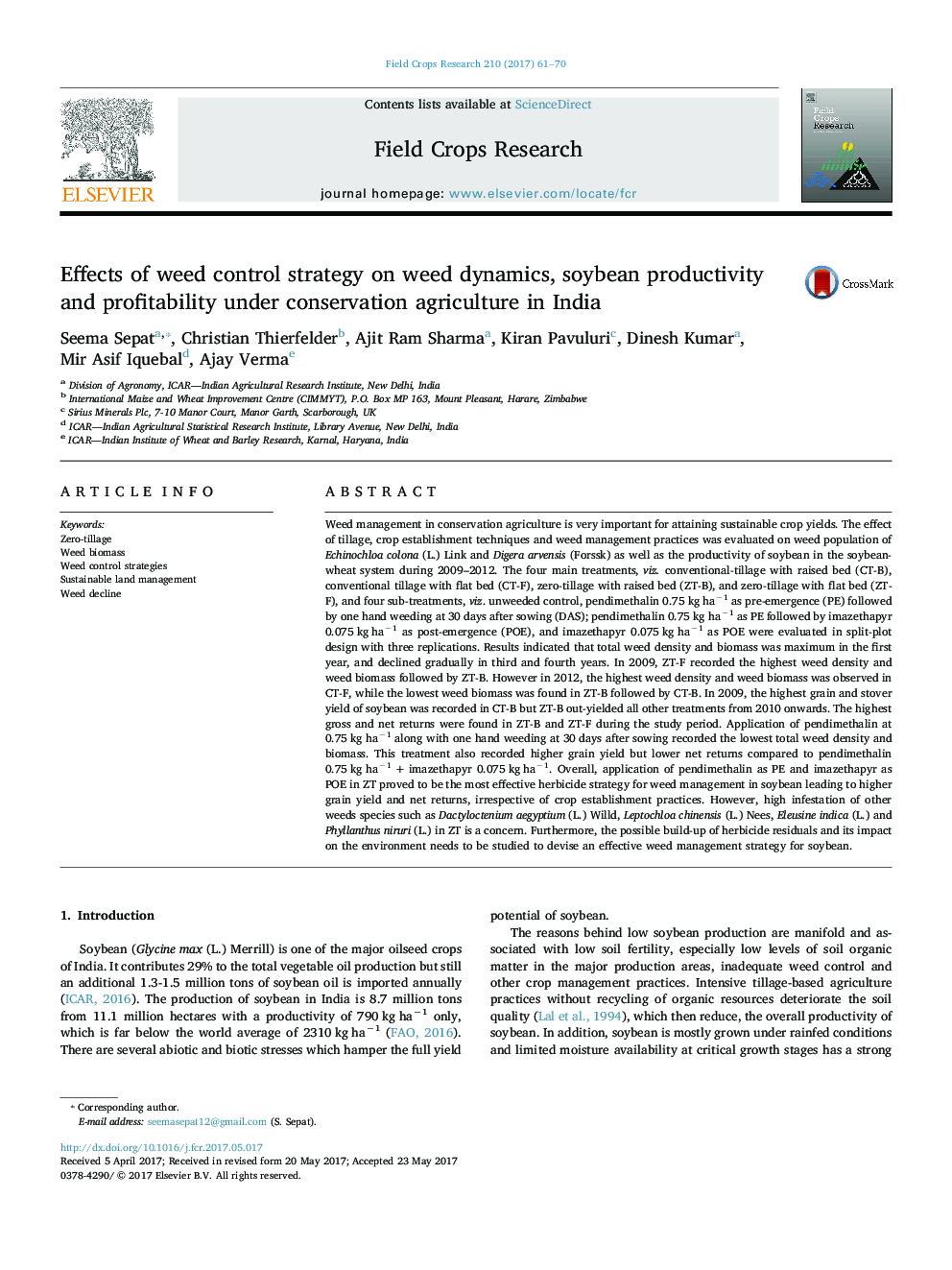| کد مقاله | کد نشریه | سال انتشار | مقاله انگلیسی | نسخه تمام متن |
|---|---|---|---|---|
| 5761435 | 1624653 | 2017 | 10 صفحه PDF | دانلود رایگان |
عنوان انگلیسی مقاله ISI
Effects of weed control strategy on weed dynamics, soybean productivity and profitability under conservation agriculture in India
ترجمه فارسی عنوان
اثر استراتژی کنترل علف های هرز بر پویایی علف های هرز، بهره وری سویا و سودآوری تحت حفاظت کشاورزی در هند
دانلود مقاله + سفارش ترجمه
دانلود مقاله ISI انگلیسی
رایگان برای ایرانیان
کلمات کلیدی
صفر خاک ورزی، زیست توده علفهای هرز، استراتژی های کنترل علف های هرز، مدیریت زمینی پایدار، کاهش علف های هرز،
موضوعات مرتبط
علوم زیستی و بیوفناوری
علوم کشاورزی و بیولوژیک
علوم زراعت و اصلاح نباتات
چکیده انگلیسی
Weed management in conservation agriculture is very important for attaining sustainable crop yields. The effect of tillage, crop establishment techniques and weed management practices was evaluated on weed population of Echinochloa colona (L.) Link and Digera arvensis (Forssk) as well as the productivity of soybean in the soybean-wheat system during 2009-2012. The four main treatments, viz. conventional-tillage with raised bed (CT-B), conventional tillage with flat bed (CT-F), zero-tillage with raised bed (ZT-B), and zero-tillage with flat bed (ZT-F), and four sub-treatments, viz. unweeded control, pendimethalin 0.75 kg haâ1 as pre-emergence (PE) followed by one hand weeding at 30 days after sowing (DAS); pendimethalin 0.75 kg haâ1 as PE followed by imazethapyr 0.075 kg haâ1 as post-emergence (POE), and imazethapyr 0.075 kg haâ1 as POE were evaluated in split-plot design with three replications. Results indicated that total weed density and biomass was maximum in the first year, and declined gradually in third and fourth years. In 2009, ZT-F recorded the highest weed density and weed biomass followed by ZT-B. However in 2012, the highest weed density and weed biomass was observed in CT-F, while the lowest weed biomass was found in ZT-B followed by CT-B. In 2009, the highest grain and stover yield of soybean was recorded in CT-B but ZT-B out-yielded all other treatments from 2010 onwards. The highest gross and net returns were found in ZT-B and ZT-F during the study period. Application of pendimethalin at 0.75 kg haâ1 along with one hand weeding at 30 days after sowing recorded the lowest total weed density and biomass. This treatment also recorded higher grain yield but lower net returns compared to pendimethalin 0.75 kg haâ1 + imazethapyr 0.075 kg haâ1. Overall, application of pendimethalin as PE and imazethapyr as POE in ZT proved to be the most effective herbicide strategy for weed management in soybean leading to higher grain yield and net returns, irrespective of crop establishment practices. However, high infestation of other weeds species such as Dactyloctenium aegyptium (L.) Willd, Leptochloa chinensis (L.) Nees, Eleusine indica (L.) and Phyllanthus niruri (L.) in ZT is a concern. Furthermore, the possible build-up of herbicide residuals and its impact on the environment needs to be studied to devise an effective weed management strategy for soybean.
ناشر
Database: Elsevier - ScienceDirect (ساینس دایرکت)
Journal: Field Crops Research - Volume 210, 15 August 2017, Pages 61-70
Journal: Field Crops Research - Volume 210, 15 August 2017, Pages 61-70
نویسندگان
Seema Sepat, Christian Thierfelder, Ajit Ram Sharma, Kiran Pavuluri, Dinesh Kumar, Mir Asif Iquebal, Ajay Verma,
